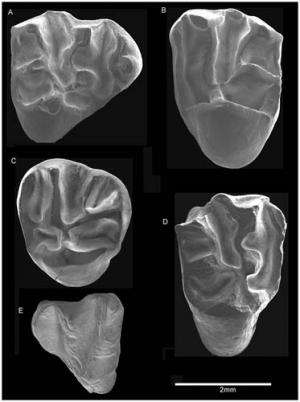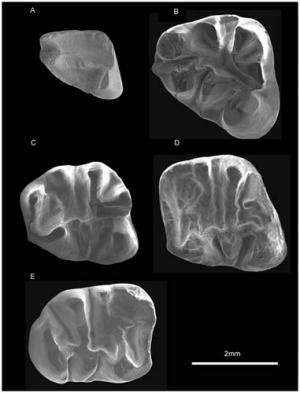New aplodontid rodent found from the late Oligocene of Northern Junggar Basin, China

Mountain beavers of the subfamily Ansomyinae are small-sized aplodontid rodents, characterized by a bucket-handle shaped ectoloph on their upper cheek teeth. Although fossils have been discovered from the Oligocene and Miocene of North America and Eurasia, the evolutionary origins and biogeography of the group are still poorly known because of relatively few records and poor representation of some taxa. Paleontologists from Institute of Vertebrate Paleontology and Paleoanthropology (IVPP), Chinese Academy of Sciences, American Museum of Natural History and Indiana University of Pennsylvania, described a new genus and species of aplodontid rodent, Proansomys dureensis, from the late Oligocene of the northern Junggar Basin of China. These specimens represent the earliest record of the subfamily in Asia and provide new information on the early history of the Ansomyinae, as recently reported in PLoS ONE 8(1).
The majority of specimens were obtained by surface collecting and screen washing from the Tieersihabahe faunal assemblage Zone I of the Tieersihabahe Formation during the 1998, 1999, 2000, 2002, and 2004 expeditions, and some materials were from Saerduoyila, approximately 50 km northwest of Tieersihabahe section in the Halamagai area. All specimens are isolated brachydont teeth. The age of the fauna is biostratigraphically and paleomagnetically correlative to the late Oligocene, around 24.4-24.15 million years ago.

The new genus is referred to as Ansomyinae because the ectoloph on the upper cheek teeth, although not fully crested, has attained the same characteristic bucket-handle-shaped configuration as other members of the subfamily. It represents the earliest record of the subfamily yet discovered in Asia and is more plesiomorphic than species of the genus Ansomys in having a partly crested ectoloph, a lower degree of lophodonty, and less complex tooth basins (lacking accessory lophules). Proansomys has transitional features between Prosciurus and Ansomys, suggesting that the Ansomyinae derived from a group of aplodontids related to Prosciurus, as did other advanced aplodontid rodents. This provides new light on the paleobiogeography of the Ansomyinae.
Proansomys dureensis is assigned to Ansomyinae because the ectoloph of upper cheek teeth, although not fully crested, has attained the bucket-handle shaped configuration that is the most important diagnostic character of the subfamily as its name implies. However, it is distinct from all other known species of Ansomys by its significantly larger size, a partly crested ectoloph, the absence of accessory lophules, lower degree of lophodonty, and the straight protoloph with crest-like protoconule on most upper molars.
"Cladistic analysis shows the new species is more primitive than species of Ansomys in having a partly crested ectoloph on upper cheek teeth, less complex dental pattern without the accessory lophules, a lesser degree of lophodonty, metaconid on m1 lingually prominent, main cusps of lower teeth not anteroposteriorly compressed, and an incomplete hypolophid on p4. Therefore, we consider this justifies its status as a new genus", said study author Dr. BI Shundong from the IVPP.
There are two alternate hypotheses for the paleobiogeography of the Ansomys. Some proposed a European origin and a series of migrations between Europe, Asia, and North America, while some proposed an origin in North America and a single migration to Eurasia in the early Miocene. "The recognition of the lineage (Prosciurus-Proansomys-Ansomys) in our study provides new insights into the early history of the ansomyines. Although the earliest record of ansomyines was A. cyanotephrus from the early late Oligocene of North America, Proansomys is the most primitive member of the subfamily and appears derived from Prosciurus-like forms. Given that Prosciurus was common in the early Oligocene in Mongolia, the ansomyines may have originated in Asia some time prior to the late Oligocene, then dispersed throughout Eurasia and North America", said BI Shundong, "However, more complete fossil discoveries will be necessary to make reliable inferences about the ansomyine paleobiogeographical relations".
This work was mainly supported by the Chinese Academy of Sciences (CAS) Key Project, the National Nature Science Foundation of China, the CAS 100-Talent Project, and the CAS Fossil Excavation and Preparation Fund.
More information: http://%20http//www.plosone.org/article/info:doi/10.1371/journal.pone.0052625
Journal information: PLoS ONE




















